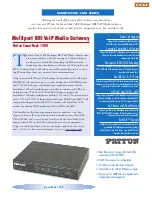
Chapter 6 WAN Setup
AMG1302-T10A User’s Guide
83
Sustained Cell Rate (SCR) is the mean cell rate of each bursty traffic source. It specifies the
maximum average rate at which cells can be sent over the virtual connection. SCR may not be
greater than the PCR.
Maximum Burst Size (MBS) is the maximum number of cells that can be sent at the PCR. After MBS
is reached, cell rates fall below SCR until cell rate averages to the SCR again. At this time, more
cells (up to the MBS) can be sent at the PCR again.
If the PCR, SCR or MBS is set to the default of "0", the system will assign a maximum value that
correlates to your upstream line rate.
The following figure illustrates the relationship between PCR, SCR and MBS.
Figure 37
Example of Traffic Shaping
6.5.1 ATM Traffic Classes
These are the basic ATM traffic classes defined by the ATM Forum Traffic Management 4.0
Specification.
Constant Bit Rate (CBR)
Constant Bit Rate (CBR) provides fixed bandwidth that is always available even if no data is being
sent. CBR traffic is generally time-sensitive (doesn't tolerate delay). CBR is used for connections
that continuously require a specific amount of bandwidth. A PCR is specified and if traffic exceeds
this rate, cells may be dropped. Examples of connections that need CBR would be high-resolution
video and voice.
Variable Bit Rate (VBR)
The Variable Bit Rate (VBR) ATM traffic class is used with bursty connections. Connections that use
the Variable Bit Rate (VBR) traffic class can be grouped into real time (VBR-RT) or non-real time
(VBR-nRT) connections.
The VBR-RT (real-time Variable Bit Rate) type is used with bursty connections that require closely
controlled delay and delay variation. It also provides a fixed amount of bandwidth (a PCR is
specified) but is only available when data is being sent. An example of an VBR-RT connection would
be video conferencing. Video conferencing requires real-time data transfers and the bandwidth
requirement varies in proportion to the video image's changing dynamics.
Содержание AMG1302-T10A
Страница 4: ...Contents Overview AMG1302 T10A User s Guide 4 ...
Страница 12: ...Table of Contents AMG1302 T10A User s Guide 12 ...
Страница 13: ...13 PART I User s Guide ...
Страница 14: ...14 ...
Страница 20: ...Chapter 1 Introduction AMG1302 T10A User s Guide 20 ...
Страница 52: ...Chapter 4 Tutorials AMG1302 T10A User s Guide 52 ...
Страница 53: ...53 PART II Technical Reference ...
Страница 54: ...54 ...
Страница 126: ...Chapter 8 Wireless LAN AMG1302 T10A User s Guide 126 ...
Страница 140: ...Chapter 9 Network Address Translation NAT AMG1302 T10A User s Guide 140 ...
Страница 158: ...Chapter 11 Filters AMG1302 T10A User s Guide 158 ...
Страница 162: ...Chapter 12 Static Route AMG1302 T10A User s Guide 162 ...
Страница 166: ...Chapter 13 Port Binding AMG1302 T10A User s Guide 166 ...
Страница 176: ...Chapter 15 Quality of Service QoS AMG1302 T10A User s Guide 176 ...
Страница 198: ...Chapter 18 Universal Plug and Play UPnP AMG1302 T10A User s Guide 198 ...
Страница 202: ...Chapter 19 CWMP AMG1302 T10A User s Guide 202 ...
Страница 206: ...Chapter 20 System Settings AMG1302 T10A User s Guide 206 ...
Страница 216: ...Chapter 21 Logs AMG1302 T10A User s Guide 216 ...
Страница 266: ...Appendix C Pop up Windows JavaScripts and Java Permissions AMG1302 T10A User s Guide 266 ...
Страница 280: ...Appendix D Wireless LANs AMG1302 T10A User s Guide 280 ...
Страница 290: ...Appendix E IPv6 AMG1302 T10A User s Guide 290 ...
Страница 322: ...Appendix G Legal InformationSafety Warnings AMG1302 T10A User s Guide 322 ...
Страница 331: ...Index AMG1302 T10A User s Guide 331 ...
Страница 332: ...Index AMG1302 T10A User s Guide 332 ...
















































